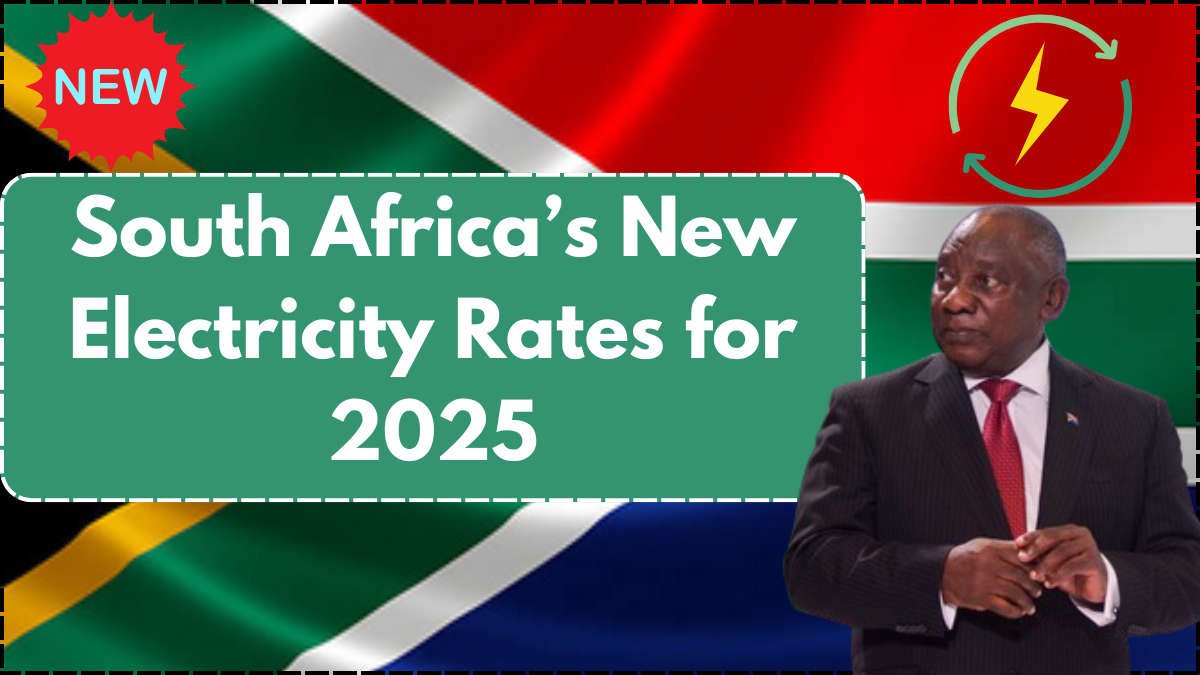South Africa is facing a substantial rise in electricity tariffs in 2025, a change that will heavily affect households and businesses. The government, working alongside energy partners, has introduced these increases to stabilize the national power grid and manage the escalating costs of energy production and infrastructure maintenance. Consumers must understand these changes, their financial implications, and how they can mitigate the effects through strategic energy use.

Overview of South Africa’s New Electricity Tariffs
The National Energy Regulator of South Africa (NERSA) has approved an electricity tariff hike for 2025. The following table provides a summary of key details:
| Key Information | Details |
|---|---|
| Tariff Increase | 15% to 20% (as per NERSA approval) |
| Primary Electricity Provider | Eskom (State-Owned Electricity Supplier) |
| Implementation Date | 2025 |
| Reason for Increase | Infrastructure maintenance, operational costs, and grid stability |
| Impact on Households | Higher electricity bills, particularly for high-consumption users |
| Impact on Businesses | Increased operating expenses, especially in energy-intensive sectors |
| Consumer Solutions | Energy efficiency measures, solar power adoption, and consumption reduction |
| Official Website | www.nersa.org.za |
Why Are Electricity Tariffs Rising?
The primary factor behind this tariff increase is the growing cost of maintaining and upgrading Eskom’s infrastructure. South Africa continues to battle severe energy supply issues, including recurring load shedding, which has placed additional financial strain on Eskom. The increase is necessary to:
- Sustain daily operations and cover rising fuel and operational expenses.
- Fund essential infrastructure repairs and ongoing maintenance.
- Invest in renewable energy and long-term power generation solutions.
- Improve national grid stability and prevent further capacity shortages.
How Much Will Tariffs Increase?
NERSA has authorized an electricity tariff hike ranging from 15% to 20%. However, the precise amount each consumer pays will depend on various factors, including:
- Regional Differences: Electricity rates may vary based on provincial energy supply costs and distribution efficiency.
- Consumption Brackets: Higher energy consumption generally results in higher electricity costs due to progressive tariff structures.
- Municipal vs. Direct Eskom Supply: Some municipalities may implement slightly different pricing structures based on local regulations and agreements.
Consumers should prepare for increased electricity bills starting from early 2025 and explore options to manage their energy expenses effectively.
Impact on Households and Businesses
Effect on Households
- Residential electricity bills will rise, with higher-consuming households seeing the most significant financial burden.
- Families that rely on electrical heating, air conditioning, and other high-energy appliances will experience an even greater increase in costs.
- While low-income households may qualify for government subsidies or support programs, the financial pressure will still be felt across all income levels.
Effect on Businesses
- Small and medium-sized enterprises (SMEs), particularly those in manufacturing, agriculture, and retail, will see an increase in operational expenses.
- Energy-intensive industries will face higher production costs, potentially leading to price adjustments or budget reductions in other areas.
- Businesses reliant on uninterrupted power supply may need to explore alternative energy solutions to maintain cost efficiency.
How Consumers Can Reduce Electricity Costs
1. Adopt Energy-Efficient Practices
One of the most effective ways to combat rising electricity costs is to implement energy-saving strategies. Consumers can:
- Upgrade to energy-efficient appliances that consume less electricity.
- Unplug devices when not in use to prevent unnecessary energy drain.
- Install smart meters and energy management systems to monitor and reduce consumption.
2. Transition to Renewable Energy
Switching to alternative energy sources, such as solar power, can help reduce dependence on Eskom. While the initial investment in solar panels and battery storage can be costly, long-term savings on electricity bills make it a worthwhile solution.
3. Advocate for Policy Changes
Citizens and businesses can actively participate in public discussions, petition policymakers, and engage with regulatory bodies to push for fair electricity pricing and improved energy policies.
For more information and official updates, visit NERSA’s website: www.nersa.org.za
Frequently Asked Questions (FAQs)
1. When will the new electricity tariffs take effect?
The tariff increase is set to be implemented in 2025, with higher rates appearing on electricity bills starting from the beginning of the year.
2. Will all consumers be affected equally by the tariff increase?
No. The impact will vary depending on factors such as location, energy consumption levels, and whether electricity is purchased directly from Eskom or a municipal supplier.
3. Are there any government subsidies available to help with the tariff increase?
Low-income households may be eligible for financial assistance or subsidized electricity rates through government programs, but details vary by municipality.
4. Can businesses pass on the cost increase to customers?
Many businesses may need to adjust pricing strategies, but this depends on market conditions and industry-specific pricing structures.
5. Is switching to solar power a viable option?
Yes. While the upfront costs can be high, investing in solar panels can provide long-term savings and reduce reliance on Eskom’s power supply.
6. What can be done to prevent further electricity tariff increases in the future?
Long-term solutions include diversifying energy sources, improving grid infrastructure, and increasing investments in renewable energy projects to reduce dependence on Eskom’s fluctuating costs.
This 2025 electricity tariff hike in South Africa will challenge households and businesses alike. However, by implementing energy-efficient practices, exploring renewable energy options, and advocating for better policies, consumers can navigate these changes more effectively. Keeping informed and proactive is key to minimizing financial strain while ensuring a sustainable and stable energy future for the country.
Akesh is a furniture expert with years of experience in design and craftsmanship. Specializing in sustainable materials, he shares his expertise to help people create stylish and functional living spaces.
